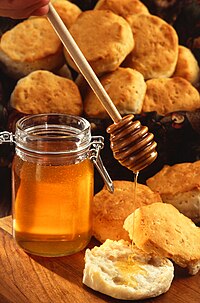
Photo from wikipedia
Honey, a naturally sweet and viscous substance is mainly produced by honeybees (Apis mellifera) from flower nectar. Honey exerts a plethora of biological and pharmacological activities, namely, antioxidant, antimicrobial and… Click to show full abstract
Honey, a naturally sweet and viscous substance is mainly produced by honeybees (Apis mellifera) from flower nectar. Honey exerts a plethora of biological and pharmacological activities, namely, antioxidant, antimicrobial and anti-inflammatory activity, because of the presence of an extensive variety of bioactive compounds. The antibacterial activity is one of the most reported biological properties, with many studies demonstrating that honey is active against clinically important pathogens. As a result, beside honey’s widespread utilization as a common food and flavouring agent, honey is an attractive natural antimicrobial agent. However, the use of neat honey for therapeutic purposes poses some problems, for instance, its stickiness may hamper its appeal to consumers and health care professionals, and the maintenance of an adequate therapeutic concentration over a sufficient timeframe may be challenging due to honey liquidity and leakage. It has motivated researchers to integrate honey into diverse formulations, for example, hydrogels, dressings, ointments, pastes and lozenges. The antibacterial activity of these formulations should be scientifically determined to underscore claims of effectiveness. Some researchers have made efforts to adapt the disc carrier and suspension test to assess the antimicrobial activity of topical products (e.g., silver-based wound dressings). However, there is currently no established and validated method for determining the in vitro antimicrobial potential of natural product-based formulations, including those containing honey as the active principle. Against the backdrop of a brief discussion of the parameters that contribute to its antibacterial activity, this review provides an outline of the methods currently used for investigating the antibacterial activity of neat honey and discusses their limitations for application to honey-based formulations.
Journal Title: Antibiotics
Year Published: 2022
Link to full text (if available)
Share on Social Media: Sign Up to like & get
recommendations!